Mauritius
Indian OceanLevel of surfing
Advanced
Quality of surf
Very Good
Call code
230
Net code
mu
Area
2040
Coastline
177 km
Climate
Tropical, modified by southeast trade winds; warm, dry winter
Hazards
Overcrowded Surf Breaks
Best Months
June - September
Population
1256739
Currency
Mauritian Rupee (MUR) Mauritian rupees per US dollar - 31.656 (2006)
Time Zone
MUT (UTC+4)
Special Requirements
Limited Surfing Supplies Available
introduction
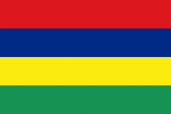
The Flag of Mauritius
The Republic of Mauritius is an island nation located off the east coast of Africa in the southwest Indian Ocean around 900 kilometres east of Madagascar. As well as the main island of Mauritius the republic also includes the islands of St. Brandon, Rodrigues and the Agalega Islands.
The official language of Mauritius is English, however, French language is more commonly spoken with a strong creole influence.
The religious beliefs of Mauritians is a mixture of Hinduism, with 52% of the population following this faith, followed by Roman Catholics at 28%, Islam at 17% and the remainder being Buddism, Christian protestants or Sikhs.
history
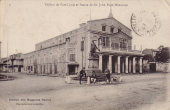
Andreas Praefcke; Port Louis Theatre, Mauritius; Circa 1910
It is thought that Mauritius was first discovered by Arab Sailors in around the 9th Century when the Island was uninhabited and densely forested. The Arabs were not interested in settling and promptly moved on after naming the island Dina Arobi. The next visitors were the Portuguese led by Fernandez Pereira in 1505 who renamed it to the Island of Cerne.
The first civilization to inhabit the island was the Dutch who took possession in 1598 when it was renamed for a third time to Warwyck Haven after vessel commander VanWarwyck. Just over 100 years later the Dutch abandoned the island in 1710 leaving behind the introduced macaque primates, java deer, sugar cane and slaves, the damage that the island had sustained during this time was irreversible. Much of the local flora and fauna had been over exploited to the point of extinction, such as the dodo.
After the Dutch, the island was settled by the French from 1715-1810 until the British invaded and took the island and renamed it Mauritius, the name that stands today. The island was then a British colony until 12th March 1968 when the Republic was granted independence within the Commonwealth.
surfing
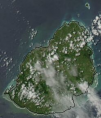
NASA: Mauritius; 2005
Sitting mostly in the Southern Hemisphere, it is the easterly tracking sub Antarctic storm cells South of Africa that peel up and supply most of the area with swell. Mauritius is no exception. April to September is the best season for spots requiring SE to SW groundswell. Island groups in the region can create some swell shadowing but generally, the sheer frequency of the southerly swells will make those spots your better option. Rarer northerly swells that descend from the Arabian gulf from May to July can light up novelty spots and mysto treats but swell decay is a problem.
Bear in mind that the southerly swells do need to 'bend' up quite a bit to feed this coast so not every system is going to yield results for you. Reliance on onshore windswells is a reality of surfing on the western side of the Indian Ocean. In between the flat periods though, chances are you are going to have some serious fun in generally uncrowded waves.
June to September is the best time of year for good waves in Mauritius. Long period groundswells from the deep southern ocean lows arrive consistently, turning on the southwest coast breaks. From September, the swell consistency drops off, however the southeast trade winds moderate and so the south coast breaks can offer better possibilities. The cyclone season December-March can produce large swells from the North, which may make an opportunistic adventure to the north of the island profitable.
By April the trades return and everyone starts looking for signs of the first Southern Ocean winter swell. The dominant oceanographic feature of the area is South Equatorial current that feeds warm tropical water to be transported pole ward by the Agulhas current, a western boundary current that forms part of the anticyclones Indian Ocean gyre. This keeps the water temperatures warm at about 27°C in summer and 22°C in winter.
travel
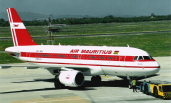
Fluglotse2000; Air Mauritius A319; 02.05.2005
Most national of many western countries do not need a visa to enter Mauritius, though do check before departure to Mauritius. The international airport is known as Sir Seewoosagur Ramoolam International (try and say that after a couple of rum punches) and is on the main island of Mauritius. Many carriers fly here from Africa, Australia, Europe and Asia and there are also regional airlines for inter island and local travel. Do make sure you have accommodation booked before arrival here and if you're come from a malaria infected country you may be required to give a blood sample for screening.
weather

WxGopher: Air masses; 9 February 2007
The climate in Mauritius is mainly influenced by the South Indian Ocean anticyclone, (also called the Mascarene high), as it shifts slightly north and south during the year with the migration of the sun but produces the persistent, steady southeast trade winds. The southeast trade winds do change in strength during the year with the shift in position of the Mascarene high and locally there are two recognised seasons: the wet season or local summer from November to April and the dry season or local winter from May to October. The southeast trades are weaker in the wet season when tropical cyclones often disrupt the trade flow. Cold Fronts are extremely rare as they normally stay well south of Mauritius. Rainfall is less than in the dry season and reaches its yearly minimum in September-October. Temperatures only vary about 10C throughout the year, with the warmest time in Dec-March and coolest temperatures July-August. Topography also plays a major role in the weather on Mauritius. Generally, the windward side of the island has more clouds and precipitation than the lee side. The main surfing breaks on the south-west shore of Mauritius including Tamarin Bay is on the lee side where it is sheltered from most of the rainfall, and the southeast trade winds which are offshore anyway.
November-April
The wet season is cloudy, rainy, and hot. Tropical cyclones are possible, especially in December-March. Mauritius is in a part of the Indian Ocean where tropical cyclones move through and the island is hit often, averaging 1 or 2 per year. These storms usually develop northeast of Mauritius and move southwest toward Mauritius before they re-curve toward the southeast. All tropical cyclones can cause strong winds, torrential rains, high seas and heavy surf, and flooding. The general wind flow is from the east to east-southeast at 7-10 knots. Rain showers are frequent, though thunderstorms are rare, only 1-2 per month. Some amount of precipitation will fall up to 20 days per month over the islands, though most of this falls on the windward locations. Extreme falls are possible if a Tropical cyclone makes landfall. This is the warmest time of year with highs around 27-30°C over the season and lows around 21°C or warmer.
May-October
The southeast trade winds are strongest in this season, and they dominate the weather, with the general wind flow from the east to east-southeast at 10-12 knots. Diurnal winds, such as land/sea breezes are likely close to the coast, but because temperatures are cooler in this season than during the warm season, these diurnal winds are generally lighter. The eastern coast gets more rain than the west coast, which occurs mainly in the first and last months of this season. Thunderstorms are rare and also only occur at the beginning and end of the season when tropical cyclones are possible. During this season, average highs stay around 24-27°C, but can reach 30°C in July or August. Average lows are stay near 16-17°C, dropping as low as 10°C some years.
where to stay
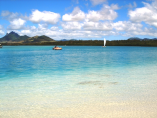
Shoestring; Ile aux Cerfs; 01.10.2006
Mauritius is a haven for the all inclusive luxury resort style holidays and accommodation at the top end of the scale. However, don't let this put you off if this type of pad is not to your taste as there are countless apartments for rent by a weekly basis as well as guesthouses, small hotels and backpackers dorms for those on a tighter budget. The most important thing really is making sure you have something booked before your arrival as customs officials will want to know where you are going and don't take too kindly if you haven't made arrangements.
what to pack
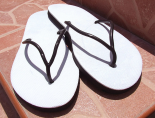
Flashdance: A pair of very simple Moroccan flip flops called "Cabjuks"; 25 May 2007
Remember to take sun protection with you everywhere you go!
Anything that protects you from the sun and the sand. Take a first aid kit with you, take sunscreen and thongs, take a backpack to protect your camera and other electronics. The sun can be very harmful, so reapplying sunscreen every couple of hours is a great thing to keep in mind as well!
Take your camera and all the equipment for it with the protection from the sand. Don't forget a backpack and rehydration sachets, that might be usefull if your planning to travel around or sail. And you won't regret swimming and snorkelling gear!
dangers and warnings
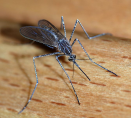
Alvesgaspar; Female Mosquito; Nov 2007
Crime levels in Mauritius are low and most crimes recorded against tourist are petty crimes such as theft. Just exercise the usual common sense when travelling here and keep a close eye on money and valuables and never leave any personal belongings unattended. The areas where it is considered that you should take extra care is Port Louis, Grand Bay, Pereybere and Tamarin as there is a small security risk in these places after dark.
Mauritius is a risk area for contracting dengue fever from mosquito bite for which there is no vaccine available, though there have been no reports of infection since 2005. Cover up with insect repellent and long sleeves, especially in rural areas.
restaurants, shopping and nightlife
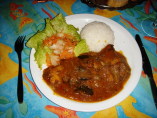
Shoestring; A creole dish in Mauritius; Oct 2006
Eating
Gastronomes will love the variety of flavours to tickle the senses in Mauritius. It has a very multicultural influence from France, India, China, and Africa. Depending on the region, different curries are favoured by the locals, usually accompanied with rice or roti bread. Spices appear in a lot of dishes such as saffron, cinnamon, cardamon and cloves and herbs like thyme, basil curry leaves are also popular.
The Mauritians also have a very sweet tooth and serve up some delicious gateaux's with a strong Indian influence such as Gulab, Jamun and Rasgulla.
Nightlife
Many hotels have bars and clubs that will keep you jumping until the small hours of the morning, though some can be a little expensive. Their local brew is called Phoenix and they claim it's one of the best in the world (hhmmmmmm!!) Though it is much cheaper than imports. You can also have a great choice of locally produced cane rum that goes down nice with a splash of coke, or better still, a little lime and some coconut milk over crushed ice. Nice!
what to do when it's flat
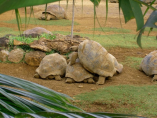
DeepPurple; Tortoises passing the time; 22.09.2007
When the surf craps out here there are still plenty of things to keep you occupied until the arrival of the next pulse.
- A two hour climb and 812m ascent from the village of Petit Verger will get you to the summit of Le Pouce to enjoy a 360 degree view of Port Louis and the north.
- You can tour the Moka mountains using various tour companies that will get you on quad bikes, horses or 4WD vehicle, whichever takes your fancy.
- Around the west coast at Flic-en-Flac, Trou aux Biches or the northern islands from Nov to April the scuba diving can be awesome and they’re plenty of companies willing to take you whether you're and experienced diver or total kook.
useful phrase guide

Indolences; Standard Question Mark; 04.05.2007
Though the official language of Mauritius is English just about everyone speaks Creole or French as well as. Most written documents, especially legal papers will be written in English.
Some useful Creole words:
Hello Bon dia
How are you? Kuma ku bu sta?
Fine, thankyou Sta bom, obrigado
What is your name? Kuma ku bu nome?
Thankyou Obrigado
Yes Si
No Não
I can't speak Creole N ka ta papia kriol
Do you speak English? Bu ta papia inglés?
Where is the toilet? Nunde i kasa de banho?






